-
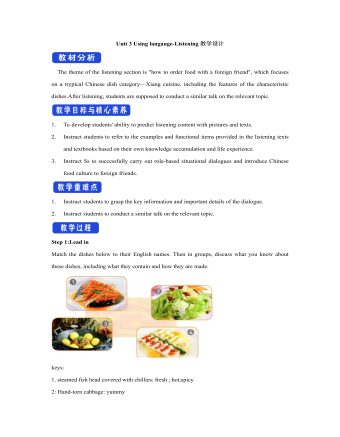
新人教版高中英语选修2Unit 3 Using langauge-Listening教学设计
1. How is Hunan cuisine somewhat different from Sichuan cuisine?The heat in Sichuan cuisine comes from chilies and Sichuan peppercorns. Human cuisine is often hotter and the heat comes from just chilies.2.What are the reasons why Hunan people like spicy food?Because they are a bold people. But many Chinese people think that hot food helps them overcome the effects of rainy or wet weather.3.Why do so many people love steamed fish head covered with chilies?People love it because the meat is quite tender and there are very few small bones.4.Why does Tingting recommend bridge tofu instead of dry pot duck with golden buns?Because bridge tofu has a lighter taste.5 .Why is red braised pork the most famous dish?Because Chairman Mao was from Hunan, and this was his favorite food.Step 5: Instruct students to make a short presentation to the class about your choice. Use the example and useful phrases below to help them.? In groups of three, discuss what types of restaurant you would like to take a foreign visitor to, and why. Then take turns role-playing taking your foreign guest to the restaurant you have chosen. One of you should act as the foreign guest, one as the Chinese host, and one as the waiter or waitress. You may start like this:? EXAMPLE? A: I really love spicy food, so what dish would you recommend?? B: I suggest Mapo tofu.? A: Really ? what's that?
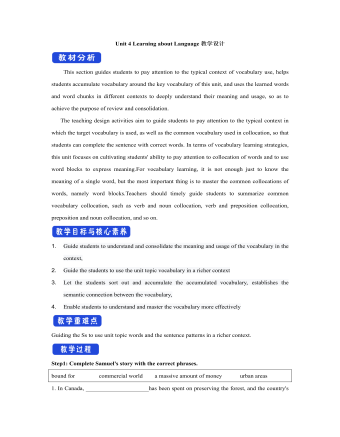
新人教版高中英语选修2Unit 4 Learning about Language教学设计
This section guides students to pay attention to the typical context of vocabulary use, helps students accumulate vocabulary around the key vocabulary of this unit, and uses the learned words and word chunks in different contexts to deeply understand their meaning and usage, so as to achieve the purpose of review and consolidation.The teaching design activities aim to guide students to pay attention to the typical context in which the target vocabulary is used, as well as the common vocabulary used in collocation, so that students can complete the sentence with correct words. In terms of vocabulary learning strategies, this unit focuses on cultivating students' ability to pay attention to collocation of words and to use word blocks to express meaning.For vocabulary learning, it is not enough just to know the meaning of a single word, but the most important thing is to master the common collocations of words, namely word blocks.Teachers should timely guide students to summarize common vocabulary collocation, such as verb and noun collocation, verb and preposition collocation, preposition and noun collocation, and so on.1. Guide students to understand and consolidate the meaning and usage of the vocabulary in the context, 2. Guide the students to use the unit topic vocabulary in a richer context3. Let the students sort out and accumulate the accumulated vocabulary, establishes the semantic connection between the vocabulary,4. Enable students to understand and master the vocabulary more effectivelyGuiding the Ss to use unit topic words and the sentence patterns in a richer context.
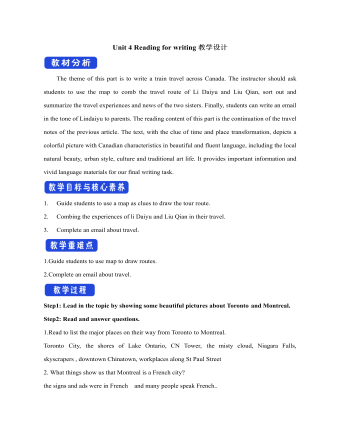
新人教版高中英语选修2Unit 4 Reading for writing教学设计
假定你是英国的Jack,打算来中国旅行,请你给你的中国笔友李华写一封信,要点如下:1.你的旅行计划:北京→泰山→杭州;2.征求建议并询问他是否愿意充当你的导游。注意:1.词数80左右(开头和结尾已给出,不计入总词数);2.可以适当增加细节,以使行文连贯。参考词汇:故宫 the Forbidden City;泰山 Mount TaiDear Li Hua,I'm glad to tell you that 'm going to visit China.First,I am planning to visit Beijing,the capitalof China,where I am looking forward to enjoying the Great Wall,the Forbidden City and somebeautiful parks.Then I intend to go to visit Mount Tai in Shandong Province.I've heard that it is one ofthe most famous mountains in China and I can't wait to enjoy the amazing sunrise there.After that,I amalso going to Hangzhou.It is said that it is a beautiful modern city with breathtaking natural sights,among which the West Lake is a well- known tourist attraction.What do you think of my travel plan? Will you act as my guide? Hope to hear from you soon.
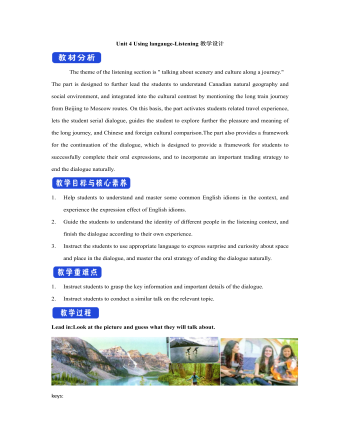
新人教版高中英语选修2Unit 4 Using langauge-Listening教学设计
The theme of the listening section is " talking about scenery and culture along a journey."The part is designed to further lead the students to understand Canadian natural geography and social environment, and integrated into the cultural contrast by mentioning the long train journey from Beijing to Moscow routes. On this basis, the part activates students related travel experience, lets the student serial dialogue, guides the student to explore further the pleasure and meaning of the long journey, and Chinese and foreign cultural comparison.The part also provides a framework for the continuation of the dialogue, which is designed to provide a framework for students to successfully complete their oral expressions, and to incorporate an important trading strategy to end the dialogue naturally.1. Help students to understand and master some common English idioms in the context, and experience the expression effect of English idioms.2. Guide the students to understand the identity of different people in the listening context, and finish the dialogue according to their own experience.3. Instruct the students to use appropriate language to express surprise and curiosity about space and place in the dialogue, and master the oral strategy of ending the dialogue naturally.1. Instruct students to grasp the key information and important details of the dialogue.2. Instruct students to conduct a similar talk on the relevant topic.
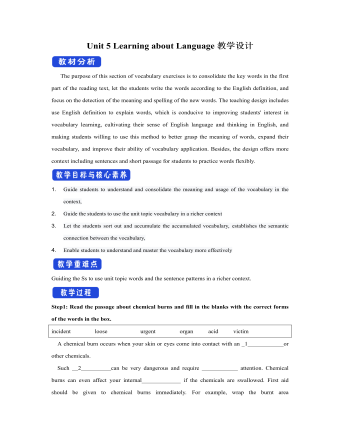
新人教版高中英语选修2Unit 5 Learning about Language教学设计
The purpose of this section of vocabulary exercises is to consolidate the key words in the first part of the reading text, let the students write the words according to the English definition, and focus on the detection of the meaning and spelling of the new words. The teaching design includes use English definition to explain words, which is conducive to improving students' interest in vocabulary learning, cultivating their sense of English language and thinking in English, and making students willing to use this method to better grasp the meaning of words, expand their vocabulary, and improve their ability of vocabulary application. Besides, the design offers more context including sentences and short passage for students to practice words flexibly.1. Guide students to understand and consolidate the meaning and usage of the vocabulary in the context, 2. Guide the students to use the unit topic vocabulary in a richer context3. Let the students sort out and accumulate the accumulated vocabulary, establishes the semantic connection between the vocabulary,4. Enable students to understand and master the vocabulary more effectivelyGuiding the Ss to use unit topic words and the sentence patterns in a richer context.Step1: Read the passage about chemical burns and fill in the blanks with the correct forms of the words in the box.
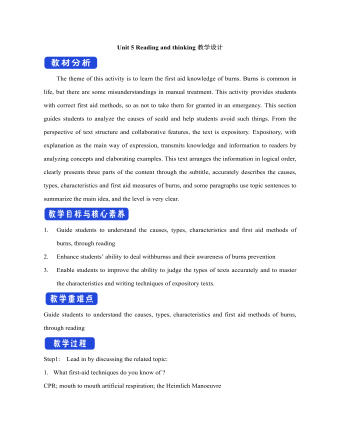
新人教版高中英语选修2Unit 5 Reading and thinking教学设计
The theme of this activity is to learn the first aid knowledge of burns. Burns is common in life, but there are some misunderstandings in manual treatment. This activity provides students with correct first aid methods, so as not to take them for granted in an emergency. This section guides students to analyze the causes of scald and help students avoid such things. From the perspective of text structure and collaborative features, the text is expository. Expository, with explanation as the main way of expression, transmits knowledge and information to readers by analyzing concepts and elaborating examples. This text arranges the information in logical order, clearly presents three parts of the content through the subtitle, accurately describes the causes, types, characteristics and first aid measures of burns, and some paragraphs use topic sentences to summarize the main idea, and the level is very clear.1. Guide students to understand the causes, types, characteristics and first aid methods of burns, through reading2. Enhance students’ ability to deal withburnss and their awareness of burns prevention3. Enable students to improve the ability to judge the types of texts accurately and to master the characteristics and writing techniques of expository texts.Guide students to understand the causes, types, characteristics and first aid methods of burns, through readingStep1: Lead in by discussing the related topic:1. What first-aid techniques do you know of ?CPR; mouth to mouth artificial respiration; the Heimlich Manoeuvre
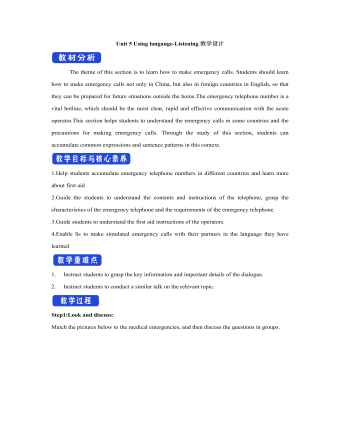
新人教版高中英语选修2Unit 5 Using langauge-Listening教学设计
The theme of this section is to learn how to make emergency calls. Students should learn how to make emergency calls not only in China, but also in foreign countries in English, so that they can be prepared for future situations outside the home.The emergency telephone number is a vital hotline, which should be the most clear, rapid and effective communication with the acute operator.This section helps students to understand the emergency calls in some countries and the precautions for making emergency calls. Through the study of this section, students can accumulate common expressions and sentence patterns in this context. 1.Help students accumulate emergency telephone numbers in different countries and learn more about first aid2.Guide the students to understand the contents and instructions of the telephone, grasp the characteristics of the emergency telephone and the requirements of the emergency telephone.3.Guide students to understand the first aid instructions of the operators.4.Enable Ss to make simulated emergency calls with their partners in the language they have learned1. Instruct students to grasp the key information and important details of the dialogue.2. Instruct students to conduct a similar talk on the relevant topic.Step1:Look and discuss:Match the pictures below to the medical emergencies, and then discuss the questions in groups.
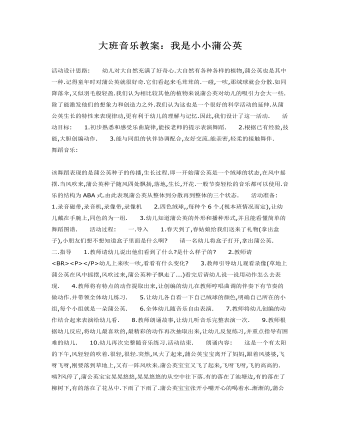
大班音乐教案:我是小小蒲公英
活动目标:1.初步熟悉和感受乐曲旋律,能按老师的提示表演舞蹈.2.根据已有经验,技能,大胆创编动作.3.能与同组的伙伴协调配合,友好交流.能亲密,轻柔的接触舞伴. 舞蹈音乐:该舞蹈表现的是蒲公英种子的传播,生长过程.即一开始蒲公英是一个绒球的状态,在风中摇摆.当风吹来,蒲公英种子随风四处飘扬,落地,生长,开花.一般节奏轻松的音乐都可以使用.音乐的结构为ABA式.由此表现蒲公英从整体到分散再到整体的三个状态. 活动准备:1.录音磁带,录音机,录像带,录像机 2.四色绒球,,每种个6个.(视本班情况而定),让幼儿戴在手腕上,同色的为一组.3.幼儿知道蒲公英的外形和播种形式,并且能看懂简单的舞蹈图谱. 活动过程:
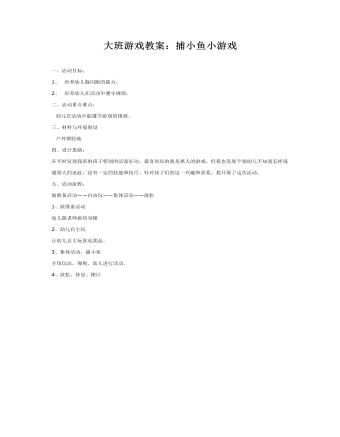
大班游戏教案:捕小鱼小游戏
二、活动重点难点: 幼儿在活动中能遵守游戏的规则。 三、材料与环境创设 户外塑胶地 四、设计思路: 在平时发现我班的孩子特别的活泼好动,最喜欢玩的就是抓人的游戏,但我也发现个别幼儿不知道怎样逃避别人的追赶,没有一定的技能和技巧。针对孩子们的这一兴趣和需要,我开展了这次活动。
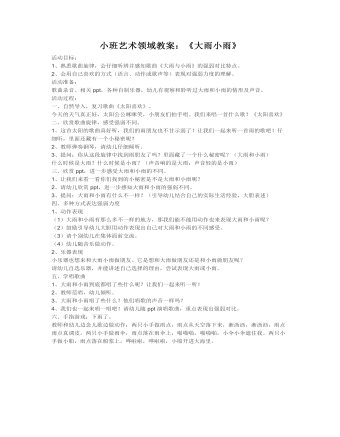
小班艺术领域教案:《大雨小雨》
2、会用自己喜欢的方式(语言、动作或歌声等)表现对强弱力度的理解。 活动准备: 歌曲录音、相关ppt,各种自制乐器,幼儿有观察和聆听过大雨和小雨的情形及声音。 活动过程: 一、自然导入,复习歌曲《太阳喜欢》。 今天的天气真正好,太阳公公咪咪笑,小朋友们拍手唱。我们来唱一首什么歌?《太阳喜欢》 二、欣赏歌曲旋律,感受强弱不同。 1、这首太阳的歌曲真好听,我们的雨朋友也不甘示弱了!让我们一起来听一首雨的歌吧!仔细听,里面还藏有一个小秘密呢? 2、教师弹奏钢琴,请幼儿仔细倾听。 3、提问:你从这段旋律中找到雨朋友了吗?里面藏了一个什么秘密呢?(大雨和小雨) 什么时候是大雨?什么时候是小雨?(声音响的是大雨,声音轻的是小雨)
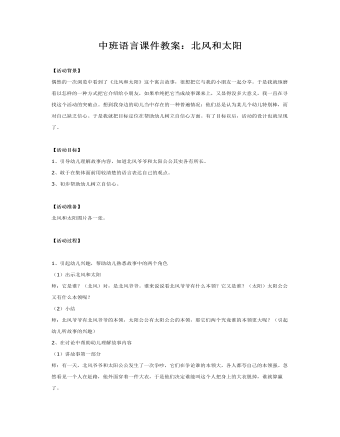
中班语言课件教案:北风和太阳
【活动目标】1、引导幼儿理解故事内容,知道北风爷爷和太阳公公其实各有所长。2、敢于在集体面前用较清楚的语言表达自己的观点。3、初步帮助幼儿树立自信心。 【活动准备】北风和太阳图片各一张。 【活动过程】 1、引起幼儿兴趣,帮助幼儿熟悉故事中的两个角色(1)出示北风和太阳师:它是谁?(北风)对,是北风爷爷。谁来说说看北风爷爷有什么本领?它又是谁?(太阳)太阳公公又有什么本领呢?(2)小结师:北风爷爷有北风爷爷的本领,太阳公公有太阳公公的本领,那它们两个究竟谁的本领更大呢?(引起幼儿听故事的兴趣)2、在讨论中帮助幼儿理解故事内容(1)讲故事第一部分师:有一天,北风爷爷和太阳公公发生了一次争吵,它们在争论谁的本领大,各人都夸自己的本领强。忽然看见一个人在赶路,他外面穿着一件大衣,于是他们决定谁能叫这个人把身上的大衣脱掉,谁就算赢了。
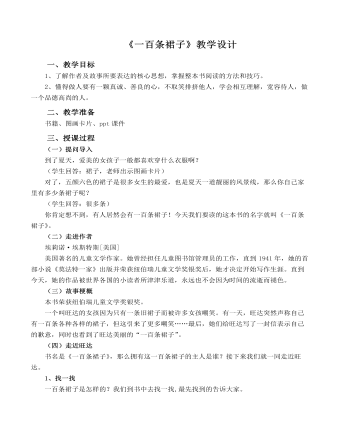
《一百条裙子》阅读课导读教案教学设计
1、书中还有许多描写旺达的片段,哪一处给你留下了深刻的印象呢?请同座位互相交流。全班交流。老师也想和大家一起分享一点感受。老师读第13页片段,并谈感受。课件出示:孤单,被嘲笑者2、你有过被人嘲笑的经历吗?谈一谈。旺达是怎样面对同学们的嘲笑?3、转学之后,十三班的同学们收到了她爸爸的来信。谁愿意读读这封信?圣诞节来临之际,旺达也写来一封信。学生读。读完这两封信,大家肯定感慨万千,一定有很多话想说吧?全班交流课件出示:善良 宽容
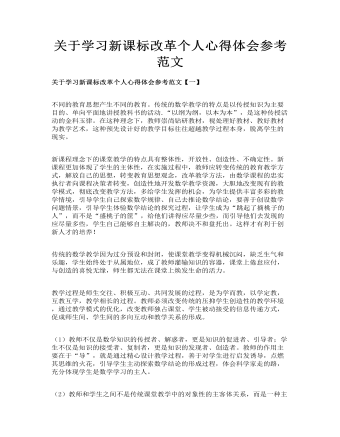
关于学习新课标改革个人心得体会参考范文
传统的数学教学因为过分预设和封闭,使课堂教学变得机械沉闷,缺乏生气和乐趣,学生始终处于从属地位,成了教师灌输知识的容器,课堂上倦怠应付,与创造的喜悦无缘,师生都无法在课堂上焕发生命的活力。 教学过程是师生交往、积极互动、共同发展的过程,是为学而教,以学定教,互教互学,教学相长的过程。教师必须改变传统的压抑学生创造性的教学环境,通过教学模式的优化,改变教师独占课堂、学生被动接受的信息传递方式,促成师生间、学生间的多向互动和教学关系的形成。
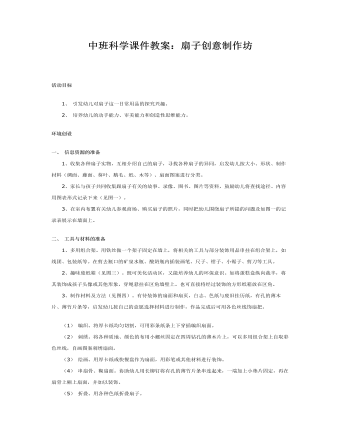
中班科学课件教案:扇子创意制作坊
2、培养幼儿的动手能力、审美能力和创造性思维能力。环境创设一、信息资源的准备1、收集各种扇子实物,互相介绍自己的扇子,寻找各种扇子的异同,启发幼儿按大小、形状、制作材料(绸面、藤面、葵叶、鹅毛、纸、木等)、扇面图案进行分类。2、家长与孩子共同收集跟扇子有关的故事、录像、图书、图片等资料,鼓励幼儿将查找途径、内容用图表形式记录下来(见图一)。3、在室内布置有关幼儿参观商场、购买扇子的照片,同时把幼儿围绕扇子所提的问题及如图一的记录表展示在墙面上。二、工具与材料的准备1、多用组合架。用铁丝做一个架子固定在墙上,将相关的工具与部分装饰用品串挂在组合架上,如线团、包装纸等。在剪去瓶口的矿泉水瓶、酸奶瓶内插装画笔、尺子、钳子、小锯子、剪刀等工具。2、趣味废纸箱(见图三)。既可美化活动区,又能培养幼儿的环保意识。如将蛋糕盒纵向裁半,将其装饰成孩子头像或其他形象,穿绳悬挂在区角墙壁上。也可直接将经过装饰的方形纸箱放在区角。3、制作材料及方法(见图四)。有待装饰的扇面和扇页,白志、色纸与废旧挂历纸,有孔的薄木片、薄竹片条等,启发幼儿按自己的意愿选择材料进行制作,作品完成后可用各色丝线饰扇把。
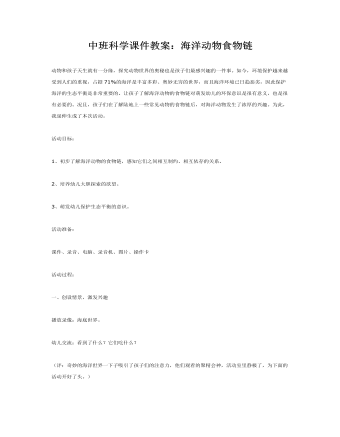
中班科学课件教案:海洋动物食物链
活动目标: 1、初步了解海洋动物的食物链,感知它们之间相互制约、相互依存的关系。 2、培养幼儿大胆探索的欲望。 3、萌发幼儿保护生态平衡的意识。 活动准备: 课件、录音、电脑、录音机、图片、操作卡活动过程: 一、创设情景,激发兴趣 播放录像:海底世界。 幼儿交流:看到了什么?它们吃什么? (评:奇妙的海洋世界一下子吸引了孩子们的注意力,他们观看的聚精会神,活动室里静极了,为下面的活动开好了头。)
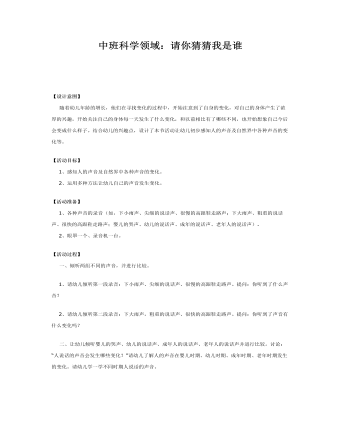
中班科学课件教案:请你猜猜我是谁?
【活动目标】 1、感知人的声音及自然界中各种声音的变化。 2、运用多种方法让幼儿自己的声音发生变化。【活动准备】 1、各种声音的录音(如,下小雨声、尖细的说话声、很慢的高跟鞋走路声;下大雨声、粗重的说话声、很快的高跟鞋走路声;婴儿的哭声、幼儿的说话声、成年的说话声、老年人的说话声)。 2、眼罩一个、录音机一台。【活动过程】 一、倾听两组不同的声音,并进行比较。 1、请幼儿倾听第一段录音:下小雨声、尖细的说话声、很慢的高跟鞋走路声。提问:你听到了什么声音? 2、请幼儿倾听第二段录音:下大雨声,粗重的说话声、很快的高跟鞋走路声。提问:你听到了声音有什么变化吗?
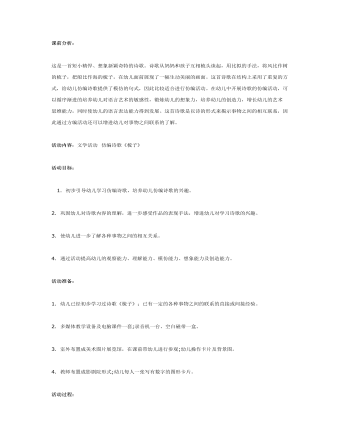
中班语言课件教案:故事:鼠宝宝学外语
活动内容:文学活动 仿编诗歌《梳子》活动目标: 1. 初步引导幼儿学习仿编诗歌,培养幼儿仿编诗歌的兴趣。2. 巩固幼儿对诗歌内容的理解,进一步感受作品的表现手法,增进幼儿对学习诗歌的兴趣。3. 使幼儿进一步了解各种事物之间的相互关系。4. 通过活动提高幼儿的观察能力、理解能力、模仿能力、想象能力及创造能力。活动准备:1. 幼儿已经初步学习过诗歌《梳子》;已有一定的各种事物之间的联系的直接或间接经验。2. 多媒体教学设备及电脑课件一套;录音机一台、空白磁带一盒。3. 室外布置成美术图片展览馆,在课前带幼儿进行参观;幼儿操作卡片及背景图。 4. 教师布置成影剧院形式;幼儿每人一张写有数字的图形卡片。
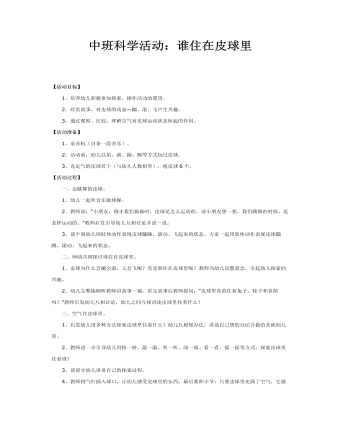
中班科学活动:谁住在皮球里课件教案
2、欣赏故事,对皮球的动态—蹦、滚、飞产生兴趣。3、通过观察、比较、理解空气对皮球运动状态所起的作用。【活动准备】1、录音机(自备一段音乐)。2、活动前,幼儿以拍、滚、抛、踢等方式玩过皮球。3、充足气的皮球若干(与幼儿人数相等),瘪皮球6个。【活动过程】 一、会跳舞的皮球。1、幼儿一起听音乐做球操。2、教师说:“小朋友,刚才我们做操时,皮球是怎么运动的。请小朋友想一想,我们跳舞的时候,是怎样运动的。”教师启发引导幼儿互相讨论并说一说。3、请个别幼儿用肢体动作表现皮球蹦跳、滚动、飞起来的状态。大家一起用肢体动作表现皮球蹦跳、滚动、飞起来的状态。
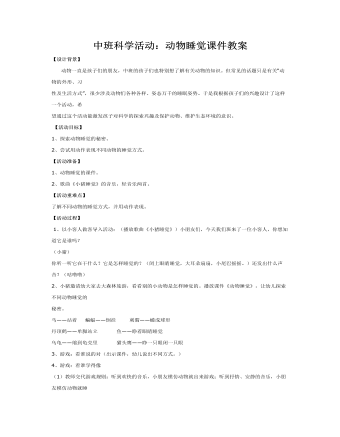
中班科学活动:动物睡觉课件教案
【活动目标】1、探索动物睡觉的秘密。2、尝试用动作表现不同动物的睡觉方式。【活动准备】1、动物睡觉的课件。2、歌曲《小猪睡觉》的音乐,轻音乐两首。【活动重难点】了解不同动物的睡觉方式,并用动作表现。【活动过程】 1、以小客人做客导入活动:(播放歌曲《小猪睡觉》)小朋友们,今天我们班来了一位小客人,你想知道它是谁吗?(小猪)你听一听它在干什么?它是怎样睡觉的?(闭上眼睛睡觉,大耳朵扇扇,小尾巴摇摇。)还发出什么声音?(咕噜噜)
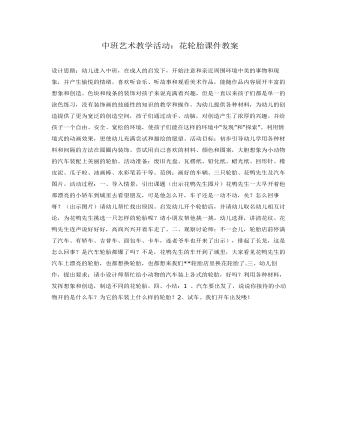
中班艺术教学活动:花轮胎课件教案
为幼儿提供各种材料,为幼儿的创造提供了更为宽泛的创造空间,孩子们通过动手、动脑,对创造产生了浓厚的兴趣。并给孩子一个自由、安全、宽松的环境,使孩子们能在这样的环境中“发现”和“探索”。利用情境式的动画效果,更使幼儿充满尝试和描绘的愿望。活动目标:初步引导幼儿学用各种材料和间隔的方法在圆圈内装饰。尝试用自己喜欢的材料、颜色和图案,大胆想象为小动物的汽车装配上美丽的轮胎。活动准备:废旧光盘、瓦楞纸、铅化纸、蜡光纸、回形针、橡皮泥、瓜子粒、油画棒、水彩笔若干等。范例:画好的车辆、三只轮胎、花鸭先生及汽车图片。

